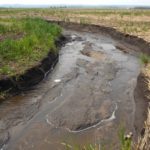First proposed by the Swedish meteorologist Tor Bergeron in the early 1920s, the Bergeron Process takes place when ice crystals form high in the cloud tops. These small, often microscopic ice crystals attract more water vapor, causing them to increase in size. As the ice crystals increase in size, the vapor pressure drops. This allows surrounding water droplets to evaporate, becoming smaller and smaller as the ice crystals grow. Eventually these ice crystals become large and heavy enough that they begin to fall towards the Earth’s surface. As they do, they pass through the lower warmer portion of clouds, attracting even more water vapor and growing larger still.
These ice crystals can then fall to the surface of the Earth as snow, or they can melt, becoming rain drops. It is believed that most precipitation happens in this manner.






